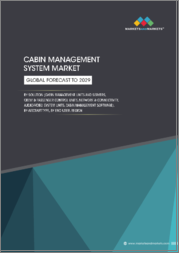
|
시장보고서
상품코드
1297046
세계의 항공기용 공기 관리 시스템 시장Global Aircraft Air Management Systems Market |
||||||
세계의 항공기용 공기 관리 시스템 시장에 대해 조사 분석했으며, 시장 성장 촉진요인, 10년간 시장 전망, 각 지역의 동향 등의 정보를 제공합니다.
목차
시장 정의
시장 세분화
- 지역별
- 항공기 유형별
- 시스템별
10년간 시장 전망
시장 기술
세계 시장 예측
지역 시장 동향과 예측
- 북미
- 촉진요인, 억제요인, 과제
- PEST
- 시장 예측과 시나리오 분석
- 주요 기업
- 공급업체 계층 상황
- 기업 벤치마크
- 유럽
- 중동
- 아시아태평양
- 남미
국가 분석
- 미국
- 방위 계획
- 최신 뉴스
- 특허
- 이 시장의 현재 기술 성숙도
- 시장 예측과 시나리오 분석
- 캐나다
- 이탈리아
- 프랑스
- 독일
- 네덜란드
- 벨기에
- 스페인
- 스웨덴
- 그리스
- 호주
- 남아프리카공화국
- 인도
- 중국
- 러시아
- 한국
- 일본
- 말레이시아
- 싱가포르
- 브라질
기회 매트릭스
전문가의 의견
결론
Aviation and Defense Market Reports에 대해
KSM 23.07.03Air management systems monitor and regulate cabin temperature, making flight for both passengers and crew members comfortable. They are essential components of the environmental control system (ECS), which maintains the aircraft's air supply, ideal cabin pressurization, and temperature management. There is more to the ECS, though. This crucial air and temperature system also controls the cooling process for avionics components and smoke detection and fire suppression.
Air cycle packs, which are located on either side of the fuselage adjacent to the main landing gear and control both airflow and air temperature, supply air to the air conditioning system of aircrafts. The air management system mixes hot and cold air, regulates airflow, and circulates cabin air for optimal ventilation in order to supply air at the ideal temperature. Packs are crucial components of any aircraft's environmental control system and are in charge of controlling things like airflow, temperature, and pressurization. Despite what the name might imply, packs are intricate pieces of machinery that include main and secondary heat exchangers, an air cycle machine, a condenser, a water extractor, a re-heater, and other crucial components. Bleed air, which enters the cabin via the aircraft's pneumatic system, is delivered to the air management system. APU pneumatic supplies or engine compressors are used to feed bleed air to the pneumatic system, which is subsequently sent to the air cycle packs' primary heat exchanger before being fed into the cabin.
Controlling air temperature is a crucial use of air management systems. This is a crucial component for businesses that manufacture aircrafts and avionics since it determines how safe, livable, and comfortable an aircraft will be. A constant 68°F (20°C) must be maintained in the cabin. The cabin staff must take action if the ambient air temperature falls or increases below or over this threshold since it may influence passenger comfort. The fact that flight conditions nearly never permit an exterior temperature of 68°F makes temperature regulation a difficult issue. Overheat switches, which are located in the air supply ducts and used by the temperature control system, can alert users when the temperature has risen above acceptable levels. The cabin temperature control panel, which shows the precise air temperature right now, receives temperature information next. The temperature controller device can then make a comparison between the real-time temperature information from the sensors and the input temperature that is intended. In order to raise the temperature to a tolerable level if it is too low, air from the pneumatic system is supplemented to the cooler section of the aircraft, but not before it is mixed with cold air.
Major factors driving the growth of the market:
For the two biggest commercial jet manufacturers, 2021 was a year of recovery after a more than difficult 2020 caused by the COVID-19 epidemic. Despite the current conflict between Russia and Ukraine, 2022 is already well under way and is anticipated to be another year of recovery for the commercial aircraft manufacturing business. However, there is still a long way to go before deliveries resume to their pre-pandemic levels at Boeing and Airbus. Hence there will be significant demand for aircraft air management systems in the years to come.
Trends influencing the growth of the market:
Newer air management systems focus on smoother pressurization control in order to make the cabin more comfortable for the occupants. This involved cutting edge electronics and efficient actuation systems. Hence advancement in semiconductors and evolution of technology such as IoT will influence the growth of the aircraft air management market.
Market Dynamics:
The International Civil Aviation Organization (ICAO) projects that both passenger and freight traffic should quadruple by 2035. An increase in middle-class disposable income and the emergence of low-cost airlines are two factors that have contributed to an increase in airline passengers. The demand for in-flight entertainment and connectivity services has grown significantly along with the increase in airline passengers. The number of passengers flying has increased in major nations like Canada, the United States, Brazil, Indonesia, the Philippines, China, Saudi Arabia, and India. When people seek to escape the monotonous routine that has emerged as the "new normal" in the wake of the coronavirus epidemic, this behavior is referred to as revenge travel or tourism. It also results from a condition known as "lockdown fatigue," or exhaustion that worsens as a result of monotony. These factors significantly increase the demand for aircraft air management systems.
Recent Developments:
Archer chooses Honeywell to supplement its expanding pool of leading suppliers from the aerospace industry by providing actuators and climate system technology for its production aircraft. Covering the delivery of heat management and flight control actuation technology. Honeywell's thermal management technology will assist Archer in giving its passengers the best-in-class in-cabin experience. Honeywell's actuation technology is a major enabler of Archer's 12 tilt 6 arrangement.
Table of Contents
Market Definition
Market Segmentation
By Region
By Aircraft Type
By Systems
10 Year Market Outlook
The 10-year market outlook would give a detailed overview of changing dynamics, technology adoption overviews and the overall market attractiveness is covered in this chapter.
Market Technologies
This segment covers the top 10 technologies that is expected to impact this market and the possible implications these technologies would have on the overall market.
Global Market Forecast
The 10-year market forecast of this market is covered in detailed across the segments which are mentioned above.
Regional Market Trends & Forecast
The regional market trends, drivers, restraints and Challenges of this market, the Political, Economic, Social and Technology aspects are covered in this segment. The market forecast and scenario analysis across regions are also covered in detailed in this segment. The last part of the regional analysis includes profiling of the key companies, supplier landscape and company benchmarking.
North America
Drivers, Restraints and Challenges
PEST
Market Forecast & Scenario Analysis
Key Companies
Supplier Tier Landscape
Company Benchmarking
Europe
Middle East
APAC
South America
Country Analysis
This chapter deals with the key defense programs in this market, it also covers the latest news and patents which have been filed in this market. Country level 10 year market forecast and scenario analysis are also covered in this chapter.
US
Defense Programs
Latest News
Patents
Current levels of technology maturation in this market
Market Forecast & Scenario Analysis
Canada
Italy
France
Germany
Netherlands
Belgium
Spain
Sweden
Greece
Australia
South Africa
India
China
Russia
South Korea
Japan
Malaysia
Singapore
Brazil
Opportunity Matrix
The opportunity matrix helps the readers understand the high opportunity segments in this market.
Expert Opinions
Hear from our experts their opinion of the possible outlook for this market.
Conclusions
About Aviation and Defense Market Reports













